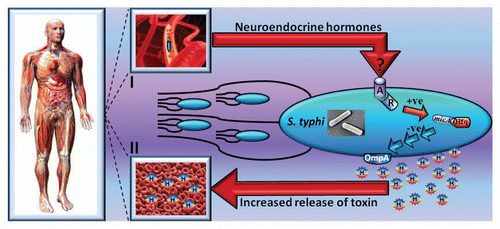Figures & data
Figure 1 Diagrammatical illustration of the interaction between S. typhi and host neuroendocrine stress hormones in the human systemic circulation leading to hemolysis of red blood cells. Hormones are sensed by S. typhi in the circulation (I) via a pathway requiring the CpxAR bacterial two component sensory transduction system (A and R respectively). Molecular signaling increases levels of the small RNA chaperone protein Hfq and the small RNA micA, thus, lowering the concentration of the outer membrane protein OmpA. Consequently, there is augmented shedding of the toxin hemolysin E (H) in membrane vesicles and hemolysis of red blood cells (II). Some of the images used in this composite figure are freeware courtesy of www.sciencephoto.com and www.oxygen-review.com.
